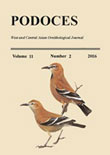فهرست مطالب

Podoces
Volume:12 Issue: 1, 2017
- تاریخ انتشار: 1396/08/30
- تعداد عناوین: 3
-
Pages 1-12The present study investigated some aspects of the breeding biology of the Bridled Tern Sterna anaethetus, a pan-tropical oceanic seabird on Nakhilu Island located in the northern Persian Gulf, Iran, during the breeding seasons of 2010 and 2011. Four stations with different types of vegetation cover were selected to estimate the effects of vegetation cover on their breeding biology. The length, width and depth of nests combined for 2010 and 2011 were 22.0±0.23 cm, 18.5±0.21 cm and 3.71±0.08 cm, respectively, and there were significant differences in nest dimensions between areas with different vegetation cover. More than 27% of nests (53 nestsout ofa total of 195 nests) were oriented towards the east while only 5.6% (11 nests out of a total of 195 nests) of nests were oriented towards the south-west and the west. The mean clutch size was calculated at 1.05±0.01 (N=4238) and there were significant differences between the mean clutch size within four categories of vegetation cover (χ23=11.884, N=219, PKeywords: Breeding, Bridled Tern, Chick, Incubation, Nakhilu Island, Nest, Persian Gulf
-
Pages 13-21Erckels Francolin Pternistis erckelii and Harwoods Francolin Pternistis harwoodi are pheasant bird species which inhabit in dryland ecosystems along vast areas of the Nile Basin. They are poorly known however, about the extent of anthropogenic disturbance on the species within their geographical locations. The present study was carried out during wet and dry seasons in 2016. Field data were collected from a total of 20 line transects ranging from 0.51.2 km, each 150400 m far apart. Line transect distance sampling was used to determine the encounter rate of the species against the human induced threats. Threats for both species were gauged by placing 10m circular plot along prearranged line transects. These plots were spaced systematically at an equal distance of 100m which gives a total of 1,064 circular plots during seven months. Various disturbance indices were analyzed by multiple linear regression and Spearmans correlation test. The estimated value of the entire multiple linear regression coefficients (R2) of various identified threats to the encounter rate of Erckels Francolin and Harwoods Francolinwere R2 = 0.87 and R2= 0.77, respectively. Based on Akaikes Information Criterion (AIC), the fittest variables against the detection of Erckels Francolin were cutting, mining and debarking (PKeywords: Erckel's Francolin, Ethiopia, Harwood's Francolin, Human disturbances, Pternistis erckelii, Pternistis harwoodi
-
Pages 22-26Scavengers such as vultures, eagles and wild boars play important ecological functions within their ecosystems. A total of 60 domestic buffalo carcasses (40 killed by tigers and 20 natural deaths) of the size of about 364 kg were recorded in forest areas in 2011 and 2015. We recorded 25 species of vertebrate fauna (19 bird and six mammal species) eating the carcasses. The presence of vertebrate scavengers was associated with five decomposition stages: initial, bloated, decay, post decay and dry. Our study provides evidence that domestic buffalo remains are routinely scavenged or visited by a broad range of avian and mammalian scavengers and decomposed by microbes. Vultures, one of the most versatile scavenging birds, were the only group of vertebrates observed during almost the entire process. Mammalian scavengers also play a significant role in carcass decomposition.Keywords: Decomposition, Domestic Buffalo, Scavengers, Sigur Plateau, Tamil Nadu, Vulture

